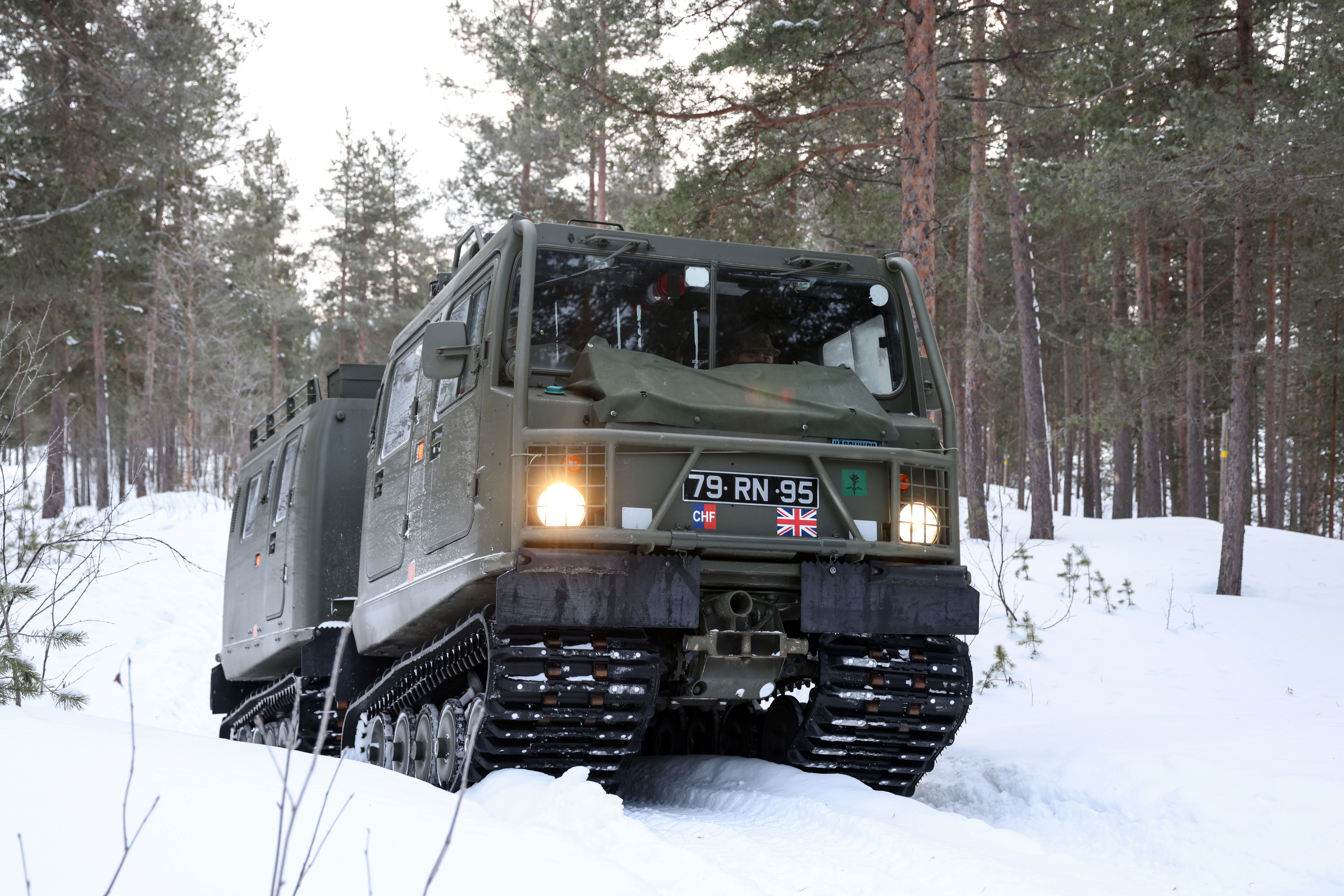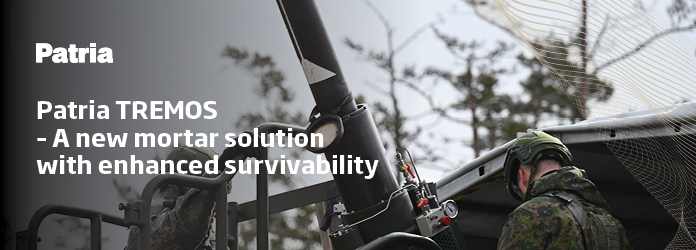Since 2020, there has been a flurry of activity in the global market for military-specification articulated all-terrain vehicles (ATVs), with contracts for close to 1,000 new vehicles signed and several more programmes approaching the threshold of contract award. This article explores the factors encouraging this demand, how the vehicles are evolving to meet customer requirements, and whether this niche capability has the potential for wider adoption beyond specialist units.
The concept of articulated steering for tracked military vehicles is not a recent innovation; designs employing this method had been proposed and experimented with even before the first tanks entered service during the First World War. However, it is only during the Cold War that the class of vehicles we would recognise as tracked articulated all-terrain vehicles (ATVs) began to be adopted for military service. While their exact form varies depending on the design, these vehicles generally consist of two halves known as ‘units’, each of which has its own pair of tracks. These units are connected together via an articulated joint in the middle of the vehicle, which allows the units to turn left or right and – depending on the degree of freedom in the articulated joint – also pitch up and down relative to one another. As suggested by their classification as ATVs, their initial military adoption was encouraged by their increased mobility in soft terrain compared to conventional tracked vehicles with just one pair of tracks. Since they still maintain this advantage over conventional tracked vehicles and because demand for mobility in challenging terrain is increasing, there remains a small yet healthy market for articulated ATVs.
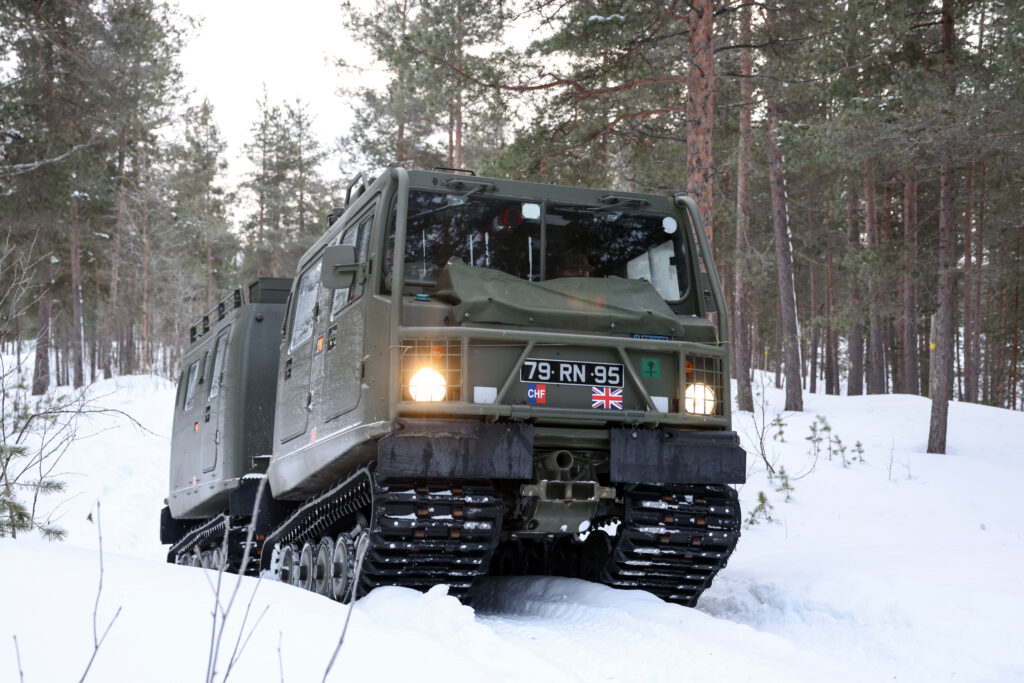
Two pairs are better than one
The advantages in mobility conferred by articulated steering have their roots in a fundamental design constraint afflicting tracked vehicles. Leaving aside the handful of vehicles that can steer by warping their tracks, in order to be able to steer a tracked vehicle with one pair of tracks, it must be fitted with a transmission that allows it to ‘skid steer’ or – in other words – vary the speed of one track relative to the other so that the vehicle turns in the direction of the slower or stopped track. For this system to work effectively, the ratio of the track length in contact with the ground to the distance between the centre of each track must remain within a range of between 1.0:1 and 1.8:1, although in practice most tracked military vehicles sit between 1.5:1 and 1.8:1. If this ratio is exceeded, the resistance to turning the vehicle caused by the friction between the slower track and the ground will make steering exceedingly difficult if not impossible. Similarly, if the ratio is lower than 1.0:1, it will be difficult for the vehicle to travel in a straight line without constant steering corrections.
This ratio imposes limitations on the overall length and width of conventional tracked vehicles. In turn, this means that larger, heavier conventional tracked vehicles suffer from an increasingly higher nominal ground pressure (NGP) because it is impossible to sufficiently increase the length of track in contact with the ground (and hence its surface area) to compensate for the increased weight of a longer, wider vehicle. Although NGP is a crude measure of the interaction between a tracked vehicle and the terrain, a higher NGP typically corresponds with reduced mobility across soft terrain with a high moisture content, such as deep snow, swampy bogs or marshland, and dense mud. This is because the increased pressure causes the soil to shear, which risks the vehicle sinking into the terrain and becoming bogged down. Moreover, as the tracks require sufficient traction on the terrain to be able to steer, this can complicate steering on soil that is more prone to shearing, as the track that is turning faster will struggle to get a grip and slip on the terrain, potentially leading to the vehicle stalling and becoming bogged down.
On the other hand, articulated ATVs are not subject to the dictates of this steering ratio. Instead, steering for these vehicles somewhat resembles that of a normal car steering along a curved path, with turning achieved by angling the front pair of tracks in a different direction to the rear pair. This means that articulated ATVs can be longer and narrower than a conventional tracked vehicle. The length of track in contact with the ground can also be longer, reducing the vehicle’s NGP relative to its weight. Furthermore, articulated ATVs require less traction to be able to steer, which further reduces their susceptibility to bogging down. The upshot of this is that tracked ATVs will have superior tactical mobility in soft terrain. An additional advantage enjoyed by some articulated ATVs is that if the joint connecting the two units can vary in pitch, the front unit can be raised to increase its vertical obstacle crossing capability.
| Table 1: Comparison of Selected Tracked AFV Mobility Specifications | |||||||
| Specification | BvS 10 | Bronco 3 | M113A3 | MT-LB | FAMOUS ATV | ACSV G5 | |
| Payload (kg) | 5,500 (APC) | 6,000-8,000 | N/A | 2,500 | 3,500 | 8,000 | |
| Nominal Ground Pressure (kg/cm2) | 0.25 | N/A | 0.59 | 0.44 | 0.33 | N/A | |
| Gradient (%) | 100 | 60 | 60 | 60 | 60 | 60 | |
| Side Slope (%) | 70 | 30 | N/A | 30 | N/A | 30 | |
| Vertical Step (m) | 1 | 1 | 0.7 | 0.61 | N/A | 1.1 | |
| Trench (m) | 2 | 2 | 1.67 | 2.41 | 2 | 2.3 | |
| Turning Radius (m) | 11 | 12 | N/A | 1.25 | N/A | N/A | |
Despite these advantages, the compromises involved in using articulated steering have militated against the adoption of articulated ATVs for most tracked military vehicle requirements. Firstly, unlike some conventional tracked vehicles, articulated ATVs are unable to perform a pivot turn, in which the vehicle rotates about its own centre point by rotating each track in opposite directions. This increases their turning radii and reduces their manoeuvrability in confined spaces, such as dense urban terrain. Secondly, the use of an articulated joint adds complexity and cost to the vehicle (though this may be offset by the lack of a complicated steering system within the transmission). Thirdly, the division of the vehicles into two halves may constrain the carriage of payloads with dimensions and weight that exceeds the envelope of one of the units. Finally, the articulated joint is difficult to protect against ballistic threats in a weight-efficient manner. Although there have been trials with articulated tanks in the past, vehicles developed for roles that require a high level of ballistic protection such as infantry fighting vehicles (IFVs) and main battle tanks (MBTs) have therefore generally eschewed articulated steering.
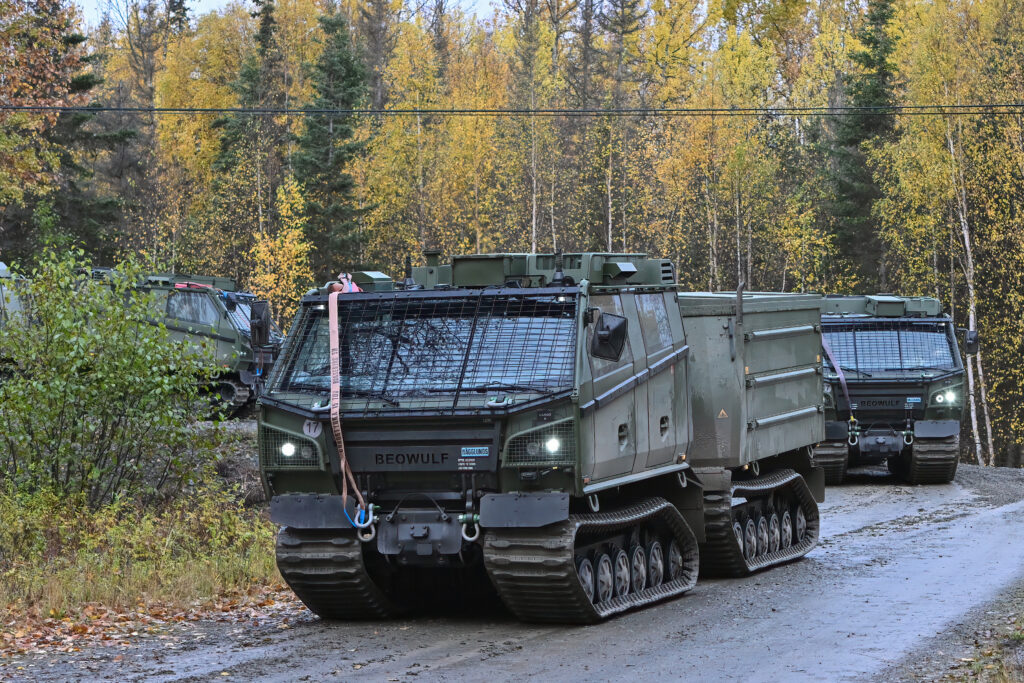
A healthy market
These drawbacks notwithstanding, articulated ATVs continue to be in demand. Between 2021 and 2024, contracts worth a combined total of USD 1.87 billion were signed for the procurement of 984 new vehicles, along with the upgrade and overhaul of a further 800 legacy vehicles.
| Table 2: Tracked Articulated ATV Contracts 2021-25 | |||||
| Customer Country | Prime Contractor | Vehicle Type | Contract Award (Year) | No. of Vehicles Ordered | Contract Value (USD Millions) |
| Sweden | BAE Systems Hägglunds | BvS10 | 2021 | 127 | 236.6 |
| Sweden | BAE Systems Hägglunds | BvS10 | 2021 | 40 | 50.0 |
| Germany, Sweden & UK | BAE Systems Hägglunds | BvS10 | 2022 | 436 | 760.0 |
| USA | BAE Systems Land & Armaments | Beowulf | 2022 | 110 | 278.2 |
| Germany | BAE Systems Hägglunds | BvS10 | 2023 | 227 | 400.0 |
| Sweden | Nordic Terrain Solutions | Bv 206 [Upgrade] | 2023 | 800 | 80.3 |
| USA | BAE Systems Land & Armaments | Beowulf | 2024 | 44 | 68.0 |
In terms of value, the largest contract was for the multinational Collaborative All-Terrain Vehicle (CATV) programme. Awarded to Sweden’s BAE Systems Hägglunds in December 2022, its initial USD 760 million contract covered the delivery of a total of 436 armoured BvS10s, of which 236 were destined for Sweden, 140 for Germany, and 60 for the UK. Germany subsequently ordered an additional 227 vehicles under the same programme’s framework agreement in April 2023. Independently of this programme, Sweden ordered a further 167 BvS10s between 2021 and 2022. The other notable procurements in this period concerned US Army orders for its Cold Weather All-Terrain Vehicle (confusingly also named CATV) programme, for which the unarmoured Beowulf variant of the BvS10 was selected. Following an initial order for 110 vehicles in August 2022, 44 more were ordered in December 2024. The programme could ultimately see up to 163 vehicles purchased from BAE Systems, although this figure was finalised before the reactivation of the Alaska-based 11th Airborne Division in 2021.
Although less information is available in the public domain, Russia and China are also active in this sector of the market. Russia utilises the GAZ-3344-20 Aleut, an unarmoured vehicle that has comparable specifications to the earlier generations of the BAE Systems’ product range. Deliveries of the unique Vityaz DT-10 and DT-30 series of vehicles have also been documented since the full-scale invasion of Ukraine in February 2022. With a payload capacity of 10 and 30 tonnes, respectively, these vehicles can accommodate a substantially higher payload than any comparable Western articulated ATV. This also enables them to be adapted to a wider range of purposes, which have included the 2S39 Magnolia 120 mm turreted mortar carrier and variants of the Pantsir and Tor air defence systems. An experimental DT-BTR armoured version, fitted with a BM-30-D unmanned turret armed with a 2A42 30 mm cannon, has also been developed and was still undergoing trials as of April 2024, according to a report aired by Krasnaya Zvezda.

| Table 3: Opportunities for Tracked Articulated ATV Procurement | |||
| Country | Programme Name | No. of Vehicles Required | Programme Value (USD Millions) |
| Canada | Domestic Arctic Mobility Enhancement (DAME) | 130-170 | 69.6–173.3 |
| India | Articulated All-Terrain Vehicle (AATV) | 18 | N/A |
| Italy | Full All Terrain Vehicle (F-ATV) | 450 | 1,330.7 |
| Netherlands | Future Littoral All-Terrain Mobility Tracked Vehicle (FLATM BV) | 50-100 | 54.1–270.7 |
Demand for articulated ATVs looks set to increase over the next ten years as a number of additional programmes progress into the contract award phase. Of which, the most lucrative could potentially be Italy’s F-ATV programme, which is anticipated to procure up to 450 vehicles worth more than USD 1 billion according to the Italian MoD’s 2024-26 budget planning document. This has been identified as an opportunity by BAE Systems and ST Engineering, with the latter revealing in March 2025 that it has teamed up with Italian companies ARIS and Leonardo to offer licensed production of the Bronco 3 in Italy. However, the Italian Army has so far only committed to funding a EUR 4 million two-year study phase for the programme, indicating that final quantities and funding allocations may yet change.
Other notable opportunities include the FLATM BV project in the Netherlands, which was originally part of the CATV programme but withdrew on the basis that it did not require an armoured vehicle to replace its Bv 206 and BvS 10 fleet. Canada is also seeking a replacement for its old Bv 206s, with the requirement having grown from 100 vehicles in 2019, up to 153 in 2021, and now to as many as 170 vehicles. There are strong indications that programmes to replace articulated ATVs could also emerge in Finland and Norway, while operators in Asia may also seek to renovate their fleets by 2030.
Specialist tools
Three main trends are apparent from these programmes. First of all, when compared to the dearth of activity in the period between 2015 and 2020, there has been an uptick in demand for articulated ATVs since 2021. This has been driven by preparations for increased strategic competition in the Arctic and along contested mountainous border regions in Asia, coupled with a growing eagerness to replace obsolescent legacy fleets. For example, the US Department of Defense (DoD) published an updated Arctic Strategy in July 2024, which specifically mentioned the need for adapted and specialised equipment capable of providing mobility in Arctic conditions.
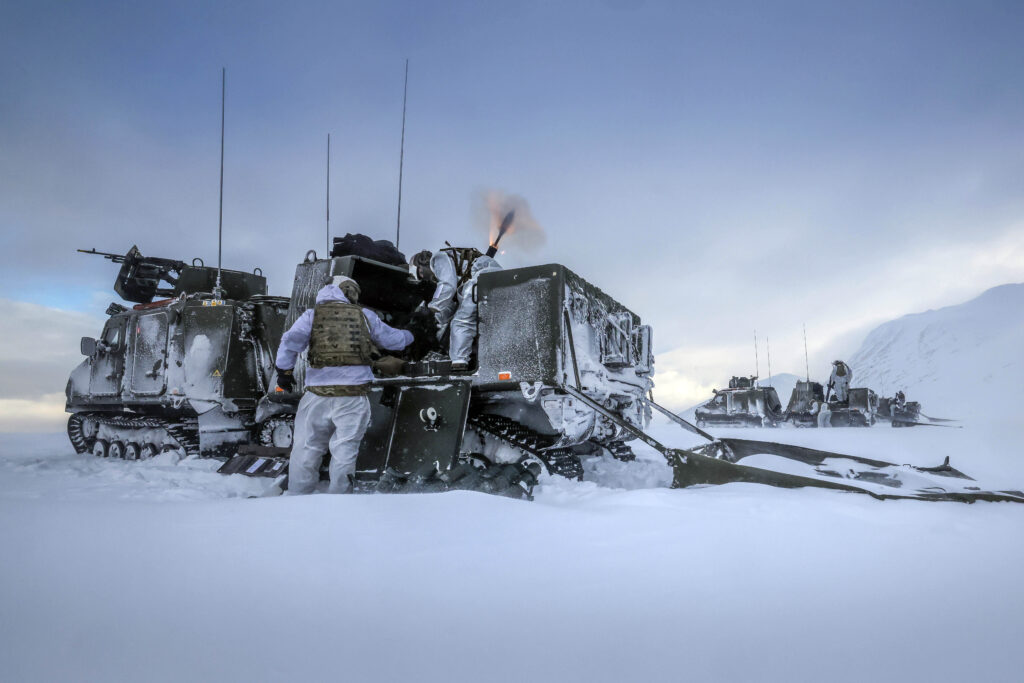
Thirdly, BAE Systems is so far the dominant player in this sector of the market, having beaten its main competitor ST Engineering for every known non-Singaporean procurement opportunity since 2015. BAE Systems’ dominance may be helped by its favourable position as the incumbent supplier in nearly the entire global market open to Western suppliers, with BAE Systems claiming to have manufactured 12,000 units of its Bv-family as of early 2025. Indeed, the only major exception to this pattern is Singapore, which has selected the domestically-developed Bronco 3 as its Next Generation Armoured Tracked Carrier. Another factor that is likely to lead to further success for BAE Systems is the economies of scale and the benefits of interoperability encouraged by the multinational CATV programme, which lessens the burden for countries that would otherwise have to pay higher costs for a small, bespoke fleet of vehicles amidst increasing competition for funding.
Less successfully, BAE Systems attempted to pitch its BvS10 family as an alternative for the APCs, IFVs, and support vehicles used by mechanised formations at DSEI 2023. Claiming that the vehicle can negotiate 80% of the globe’s terrain, the company has suggested that its “hypermobility” could increase survivability by making mechanised formations more versatile and thus less predictable to the enemy. While there so far appears to be no signs that this vision has been embraced by its customers, the war in Ukraine has called into question the survivability of some heavier, more expensive IFVs in a battlespace characterised by pervasive surveillance technologies and with a constrained area of operations for vehicles that rely on a vulnerable logistical tail, cannot swim across water, and struggle to negotiate challenging terrain such as marshes or woodland.
Open to all roles
BAE’s leading market position has been secured by two product ranges: the armoured BvS10 and its unarmoured derivative, the Beowulf. This approach is mirrored by ST Engineering, which offers the armoured Bronco 3 and the unarmoured ExtremV. In January 2025, the Finnish company Sisu also introduced a derivative of the Bronco 3 known as the GTT. Sisu states that this version has components commonality with the Sisu GTP 4×4 protected patrol vehicle (PPV) that has been procured by Finland and Sweden, although it has not provided further details on the extent of this commonality.
When comparing the existing offerings in the armoured and unarmoured space with their predecessors, one of the main trends is an increase in their payload and overall gross vehicle weight (GVW). For example, BAE Systems’ earlier Bv 206S armoured vehicle had a payload capacity of 1,550 kg and a GVW of 7,000 kg, which grew to 2,800 kg and 11,300 kg, respectively, on the original version of the BvS 10. Further increases in payload capacity to between 6,000 and 8,000 kg, and GVW to between 16,000 and 18,000 kg were achieved on the later BvS 10 Mk IIb, representing up to a 416% increase in payload compared to the Bv 206S. This reflects broader trends in military vehicle development, where pressures to integrate increased passive and active protection, heavier weapon systems, additional sensors, and more networking capabilities are driving GVW upwards and necessitating vehicles with greater growth potential than was necessary in the past.

Despite these developments, armoured articulated ATVs remain lightly armed and armoured compared to dedicated tracked IFVs, especially in their base configurations. Neither the BvS 10 nor the Bronco 3 has been demonstrated with a turreted weapon station armed with a medium-calibre cannon typically, as is typically fitted to an IFV. Furthermore, the basic ballistic protection of the BvS 10 Mk IIb displayed at DSEI in 2023 was stated to be equivalent to NATO STANAG 4569 Level 2, with further increases to Level 4 standards of ballistic protection requiring valuable payload capacity to be consumed by a ceramic armour kit.
Following the developmental current of the wider military vehicle market, there is also experimentation with adding unmanned capabilities and hybrid drivetrains into tracked articulated ATVs. In March 2019, ST Engineering presented a version of the Bronco 3 with an unmanned rear module equipped with a hybrid-electric drive that could be remotely operated up to a range of 20 km. One operational benefit of such a configuration may be to reduce the risk to operators of high value tactical targets such as air-defence systems or radars, as the crew could separate themselves from the system by operating it from the front unit.
Hybridisation has also been trialled in the High Mobility Land Platform (HiMoLaP), which German company FFG presented to Germany’s defence procurement agency in June 2021. This was fitted with a form of mild hybridisation in which an electric motor was used to provide a boost to the conventional drivetrain, but full hybridisation is mentioned as a potential offering for the vehicle. If this technology can be matured to a state where it is sufficiently reliable for military requirements in extreme weather conditions, it is likely that it will be adopted for use on articulated ATVs, as the potential for hybrid vehicles to export power offboard will be especially useful for supporting operations in austere environments.
An expanding niche?
This ongoing development and the continued demand for articulated ATVs indicates that they remain valuable niche capabilities for militaries requiring mobility in environments characterised by soft terrain. Peering into the future, the main question is whether they can also capture part of the market for general-purpose tracked AFVs. With many militaries still operating vast numbers of ageing, lightly armoured tracked vehicles such as the M113 and MT-LB in support roles, these will need to be replaced in some form. Articulated ATVs offer one option for this, but they are likely to face competition from other low-cost, lightweight tracked vehicles, with Patria’s FAMOUS ATV being one notable recent example of this. Faced with the need to increase mass, militaries may also be more inclined to accept the compromise of worse tactical mobility in soft terrain and consider cheaper wheeled vehicles for these requirements. Even though articulated ATVs still have the advantage of many superior mobility characteristics over these competitors (see Table 1), their prospects of success will hinge on whether military requirements evolve to place greater emphasis on tactical mobility at the expense of other factors such as cost or protection. So far, however, there is little sign of the change in mindset necessary to justify their acquisition outside of specialist roles.
Jim Backhouse



